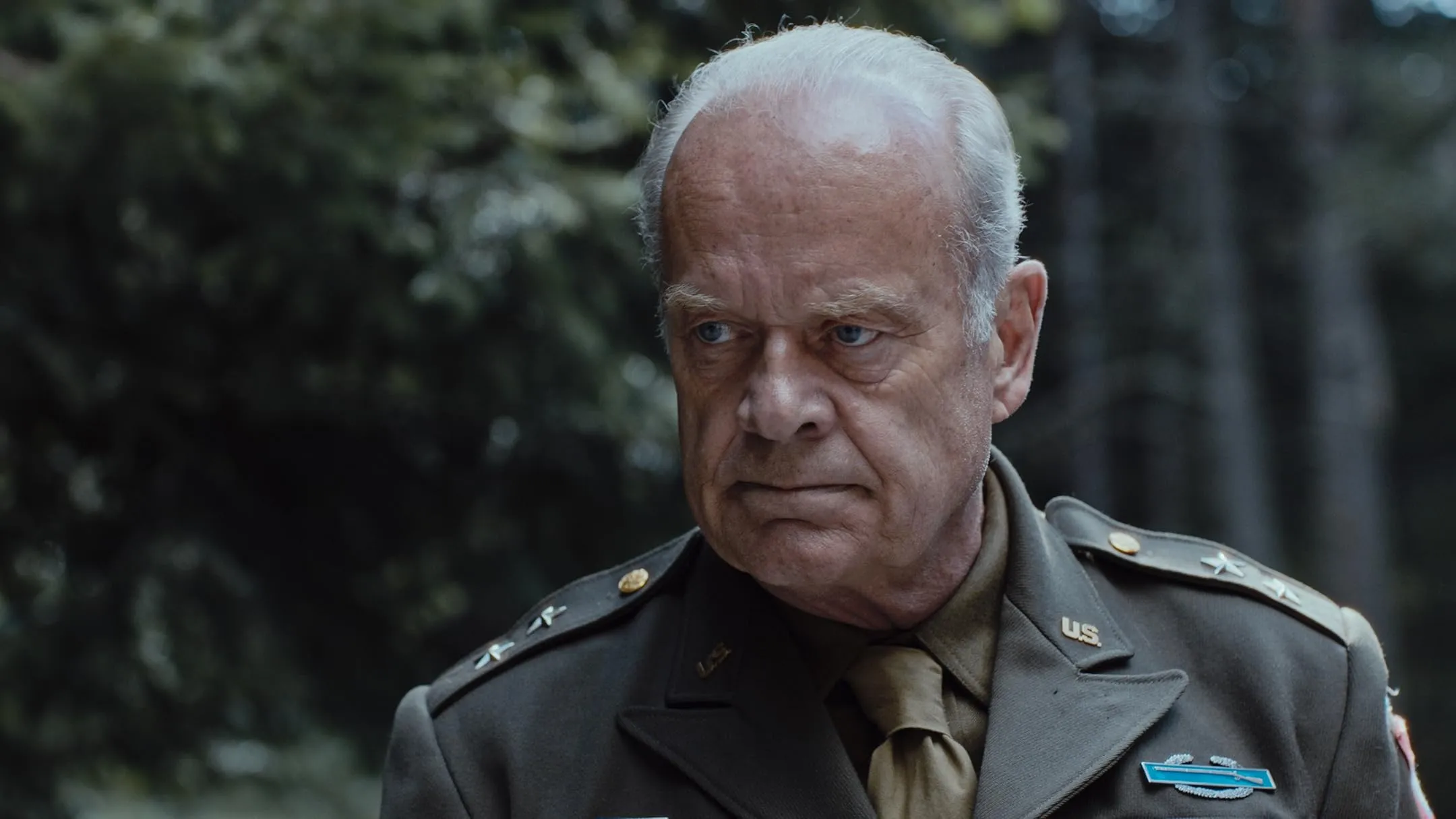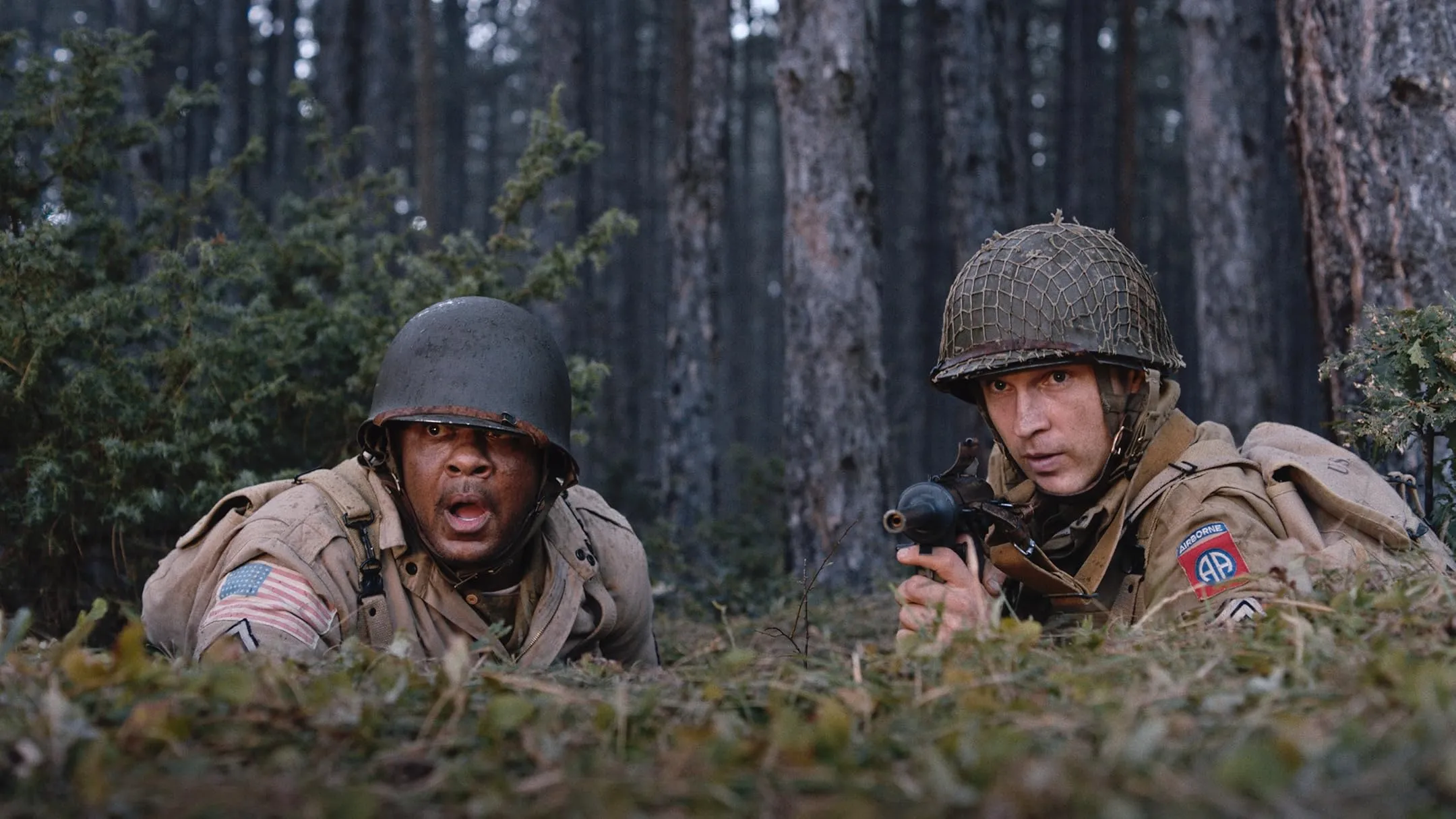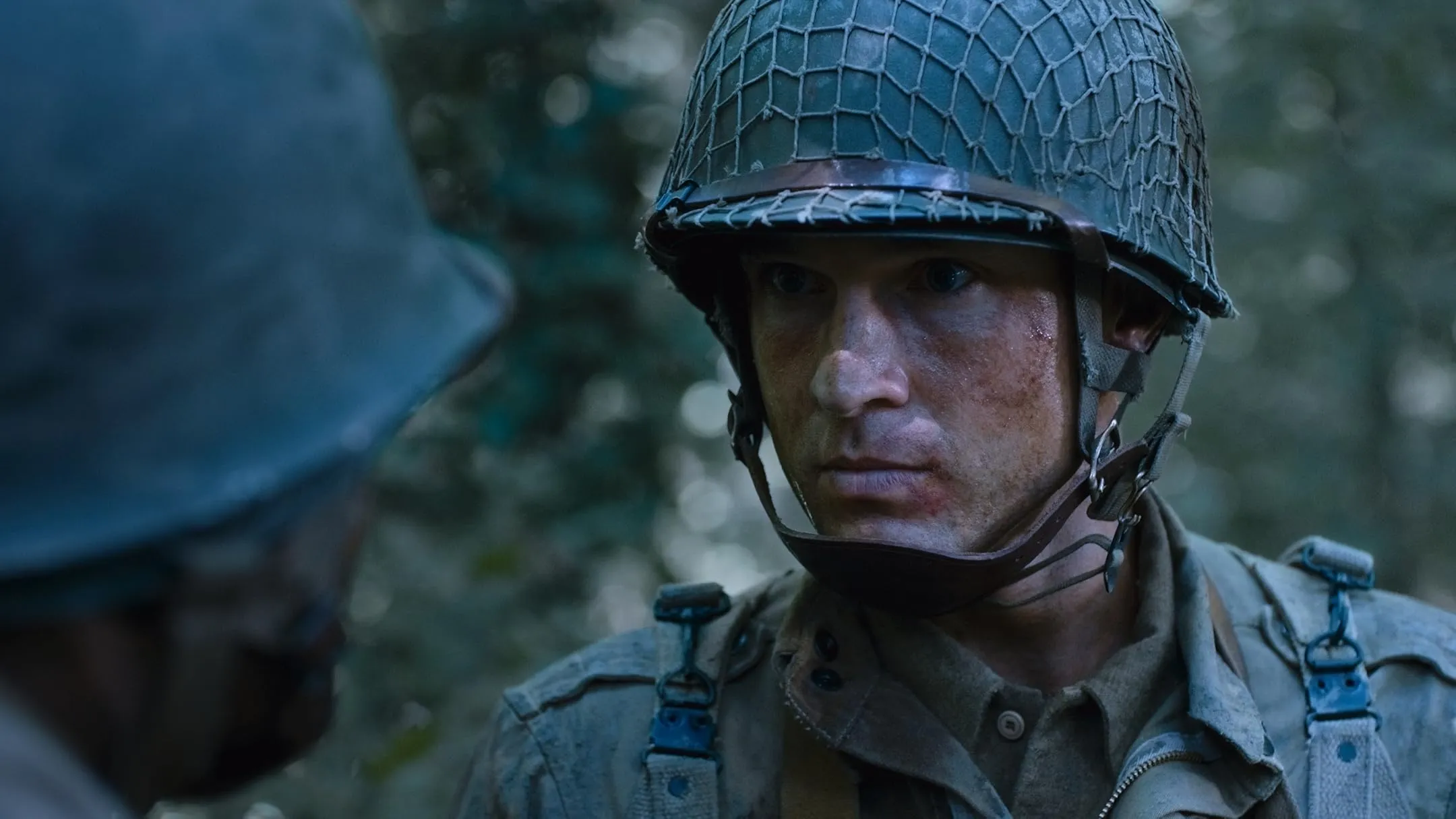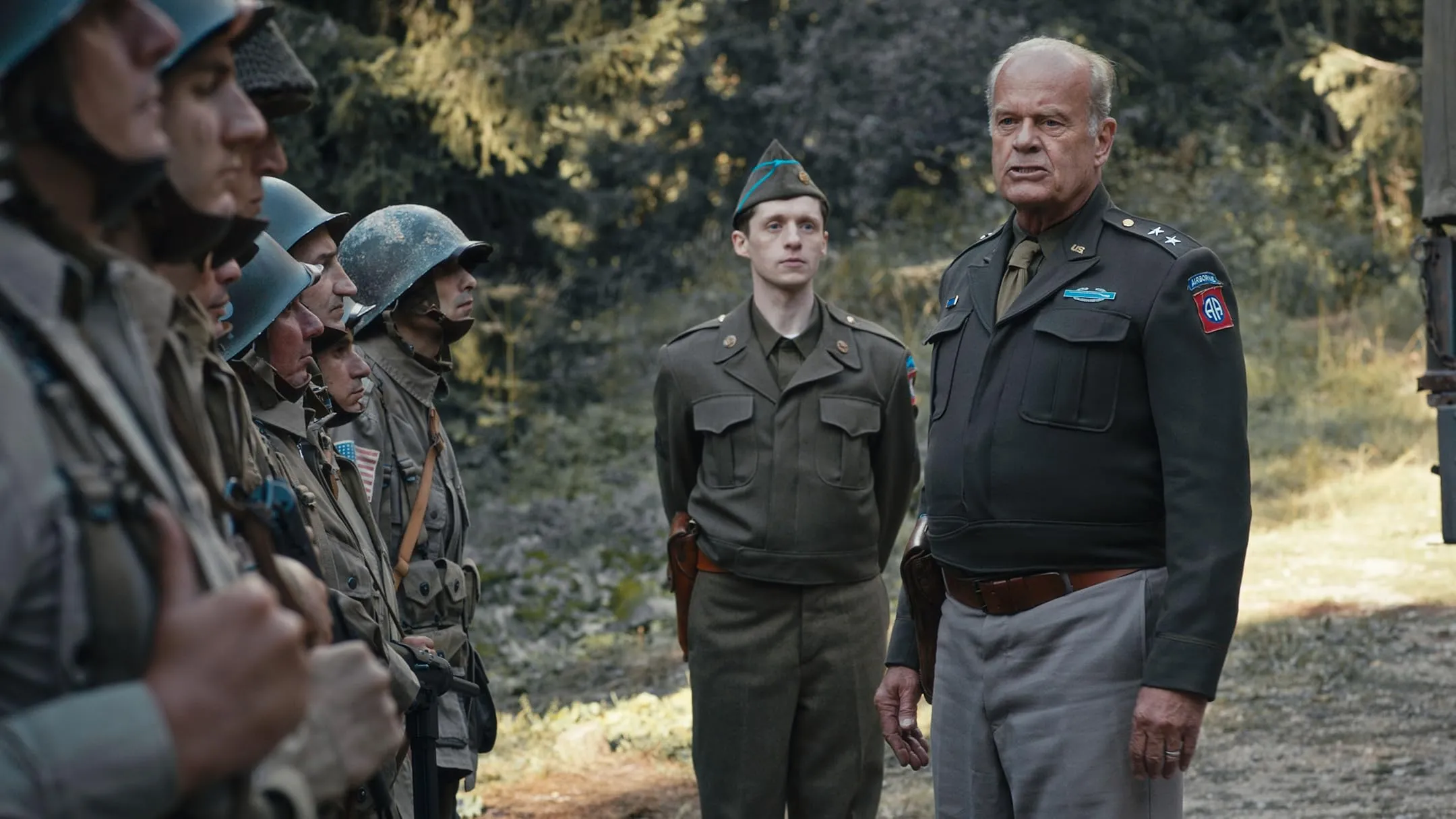The story of “Murder Company” occurs just days before D-Day, during World War II. The 82nd Airborne General Haskel (Kelsey Grammer), who sends a group of five soldiers on a covert mission to rescue a French Resistance member and kill a high-ranking Nazi officer, is the main character of the film. This project is full of moral ambiguity, which makes viewers ponder the moral problems with war.
The film, released on July 5th, Independence Day, presents a more complex exploration of duty and sacrifice. Audience members might anticipate stirring tales of heroism, but “Murder Company” leans more toward character-driven narratives, which deviates from typical war film formulas.
As we talk about the morality of war today, the movie’s title, “Murder Company,” provocatively captures the duality of heroism and villainy in conflict. In the end, the film makes the audience grapple with difficult themes like the nature of heroism and the cost of war.
The Burden of Command: Analyzing the Plot of “Murder Company”
A squad of soldiers led by General Haskel (Kelsey Grammer) is tasked with rescuing a trapped French Resistance fighter and killing a high-ranking Nazi officer. At its core, “Murder Company” presents a secret mission fraught with moral dilemmas. This mission, set against the looming D-Day deadline, is more than just a tactical move; it’s a fight for the soul of war. The film skillfully shows how the stakes of one secret operation can reflect the larger narrative of freedom and sacrifice, underscoring the complex web of human conflict.
As the soldiers get together, their backgrounds and motivations clash, creating a miniature version of bigger societal problems, especially the tension between duty and morality. When the lines between ethics and mission are blurry, what does it mean to be a soldier? Through the characters’ interactions, which are frequently filled with dark humor and camaraderie, the film addresses this question. The joking about “lousy krauts” and long-distance sweethearts serves as a coping strategy, revealing the psychological toll of their mission.
As they move through enemy-occupied land, important plot points develop, with each encounter with German patrols raising the stakes and revealing character nuance. Despite being limited by price, the action scenes in the film advance the narrative. We see small, personal fights that capture the chaos of war instead of big, epic battles. These moments of tension are punctuated by fleeting glimpses of humanity, reminding us that behind every gunfire are people grappling with their fears and loyalties.
However, the film doesn’t shy away from showing the repercussions of their actions, especially when they grapple with their role as assassins rather than regular soldiers. The contrast between the ideal of heroism and the reality of murder encourages reflection on current military conflicts where similar moral ambiguities still exist. In an era where the ethics of war are being looked at more closely, “Murder Company” serves as a reminder of the heavy burdens carried by those who serve, making it a moving, if flawed, exploration of the nature of bravery and sacrifice.
The Fragile Humanity of War: Character Dynamics in “Murder Company”
In “Murder Company,” Kelsey Grammer’s character, General Haskel, is a strange anchor in the chaos. He embodies the ideal leader during the war: stern, determined, and distant (imagine Eisenhower meeting a cigar-chomping grump). His leadership style is less about motivational talks and more about tough realism, making people wonder about the command’s true nature.
Does real leadership require being able to separate your emotions? That’s what Haskel seems to think. But his short screen time makes you want to know more about his mind and explore it further. After all, the audience wonders what burdens he carries behind that tough exterior.
The group of soldiers, including Southern (William Moseley), Coolidge (Pooch Hall), Smith (Joe Anderson), Stubbs (Jilon Vanover), and Miller (Ian Niles), provides a more nuanced view of the human experience in wartime. While Coolidge’s witty banter serves as both comic relief and a coping strategy for the horrors they face, Southern emerges as a reluctant leader grappling with responsibility. Their interactions frequently swing between camaraderie and conflict, revealing the fragility of their humanity. Men with fears, doubts, and moral problems are not just a group of brothers; they are men.
Last but not least, Jean Daquin, a French Resistance fighter, makes the soldiers’ inner battles worse. His motivations are very personal—the murder of his family by Nazis is very important to him. This contrasts sharply with the American soldiers, who are dedicated but not fighting for their country. They are not just soldiers; they are assassins, and Daquin’s presence makes them confront the reality of their mission. Due to Daquin’s resolve, which challenges their ideas of heroism and respect, this dynamic adds another level to their interactions.
The film skillfully captures these tensions, showcasing how their backgrounds and motivations influence their relationships. The soldiers’ jokes serve as a lifeline and a means of navigating the absurdity of their situation in the face of impending danger. However, these lighthearted moments are tinged with a deep sense of impending loss, reminding us that camaraderie in war is often a thin veneer. The lines between friend and foe, hero and villain, become more hazy as the plot progresses, and the characters must confront external enemies and internal conflicts. The battle to find meaning in chaos is a theme that resonates in both historical contexts and modern conflicts, and this complexity speaks to a bigger societal problem.
The Art of War: Evaluating Performances in “Murder Company”
Kelsey Grammer’s performance as General Haskel is an interesting mix of seriousness and reserve. He embodies the ideal leader: calm, in charge, and sometimes grumpy (you could almost hear him giving a Frasier-style speech about the burdens of command). Still, there’s a subtlety to his acting that suggests there’s more trouble going on beneath the surface.
The fact that his character is mostly kept to the background lines, leaving viewers to ponder the full extent of his struggles, is unfortunate. Is he a tough warrior or a man who can’t get over the choices he’s made? The latter is teased in the film, but it is never fully developed.
Pooch Hall, on the other hand, really shines as Coolidge, easily mixing charm and bravado. His ability to say sharp, funny things while grappling with the seriousness of his mission gives the character more depth. Hall’s acting serves as a much-needed counterbalance to the film’s darker themes, offering lighthearted moments among the tension.
In his role as Daquin, Gilles Marini shines, performing with much energy. The film is grounded in emotional authenticity by his portrayal of a man wanting revenge for his family’s murder, which resonates strongly. The narrative is layered, raising the stakes for the soldiers as Daquin tries to balance his grudge with the group mission.
“Murder Company” really shines when the actors get along with each other. The interactions between Southern, Coolidge, and the others weave a tapestry of conflict and camaraderie that shows what it’s like to be human during war. Their jokes seem real, a reflection of the absurdity of their situation and the weight of their job. The underlying tensions, however, point to the fragility of their ties even as they make connections.
Individual acts are interesting, but how the group works together sticks with you. The characters’ reactions to danger—humor, fear, and bravado—echo larger social problems with conflict, showcasing how different people deal with trauma. These performances remind us of the shared humanity that endures even in the darkest of times in an era where the impact of war continues to resonate.
Navigating the Battlefield: Direction and Writing in “Murder Company”
In “Murder Company,” Shane Dax Taylor’s direction exhibits a certain pragmatism, balancing the film’s pacing with moments of tension and introspection. The visual storytelling isn’t nothing new but shows war’s chaos and the weight of moral choices.
The pacing, however, can feel off at times—moments of fast-paced action are interspersed with quieter scenes that focus on the characters, creating a narrative rhythm that occasionally falters. This makes Taylor seem like she’s walking a tightrope between action and reflection and falls a few times along the way.
A strange and interesting choice was made to film in Bulgaria instead of France. The landscapes feel dislocated, as they fit the film’s wartime setting. After all, is it the French countryside or just Bulgarian farmland dressed in historical clothes? This choice emphasizes the film’s lower budget but also speaks to the larger theme of authenticity in storytelling: what does it mean to show a real place when reality is filtered through a lens of fiction?
Jesse Mittelstadt wrote the script, which shows both its strengths and flaws. While it has some memorable lines that resonate with the audience, such as “Allied intelligence has been keeping an eye on a Frenchman who is part of the Maquis,” “That’s the French resistance, Miller—try and keep up” sums up the film’s tendency to explain things. It also uses a lot of clichés, which can sometimes detract from the character’s motivations.
While there are many genuine moments of camaraderie in the dialogue, it also occasionally goes into predictable territory, acting more as a means of story advancement than as a means of getting to know the characters’ inner lives.
The nature of war narratives in film is eventually reflected in “Murder Company” as it navigates these difficulties. The interaction between the director’s choices and the script shows the complexities and contradictions inherent in storytelling—where the desire for authenticity meets the limits of artistic representation, leaving the audience to ponder the deeper implications of what they are seeing on screen.
The Weight of Choices: Themes and Messages in “Murder Company”
“Murder Company” digs deeply into the moral quandaries of war, grappling with the moral ramifications of its main mission: assassination while pretending to be a soldier. Is killing for a cause okay, or does it permanently stain the soul? These are some of the tough questions the film raises.
The character of Jean Daquin, whose personal stakes—driven by the loss of his family—add a touching layer to the narrative, exhibits this conflict particularly strongly. His search for revenge shows how complicated righteous anger can be and warns about the cost of such motivations.
Their camaraderie is both a safety net and a hindrance as the soldiers negotiate these dangerous waters. The film references the theme of brotherhood, which shows how men in battle can form strong bonds through shared experiences. But this bond has some problems as well. While they help each other, they also face the harsh reality that their lives are unimportant in war.
The film nuancedly depicts sacrifice, revealing that true loyalty frequently has an emotional cost. In this way, “Murder Company” is a microcosm of bigger societal problems because it shows how relationships formed in the crucible of conflict can both help and hurt people, eventually calling into question what it means to fight for the greater good.
Crafting War: Technical Aspects of “Murder Company”
Although it occasionally veers toward cinematic glossiness that detracts from its gritty reality, the visual style of “Murder Company” exhibits a commendable adherence to period accuracy. While not groundbreaking, the photography successfully captures the rawness of war by using natural light and muted colors to convey a sense of authenticity (think less Hollywood shine and more muddy boots).
Even though the budget limits the action scenes, they are filmed with a real sense of energy. There are more practical effects than CGI, which is nice in a world where digital effects are overused. But this focus on practical effects can lead to uneven quality—sometimes, a lack of polish takes away from moments of visceral reality.
Sound design plays a crucial role in creating tension throughout the film. The crack of gunfire, the rustling of leaves, and the faraway echoes of conflict immerse the audience in the chaotic environment. This soundscape raises the stakes and pulls viewers into the soldiers’ terrifying experiences.
The score is fine, but it’s all very familiar. It swells at the right moments without becoming overly manipulative, underscoring emotional points. Still, it’s hard not to wish the film had a more unique sound style that would have brought out its deeper themes. In the end, the technical aspects of “Murder Company” reflect both its strengths and its limits, underscoring the delicate balance between artistic ambition and practical execution.
Reflections on Conflict: The Standing of “Murder Company”
“Murder Company” presents an engaging, if uneven, exploration of the moral complexities of war, bolstered by strong performances and a strong sense of camaraderie.
Its strengths are the complex portrayal of moral problems and the character dynamics, which resonate with current societal issues surrounding military involvement. The film, however, suffers from inconsistent pacing and a plot that occasionally undercuts its thematic goals.
“Murder Company” is a thought-provoking addition to the war genre. Though there are a few bumps in the road, it has both gritty reality and philosophical musings. For those ready to consider its deeper messages, it challenges perceptions, making it worthwhile to watch.
The Review
Murder Company
"Murder Company" is a thought-provoking war film that grapples with the moral complexities of war. It is bolstered by strong acting and a palpable sense of conflict among its characters. It does a great job of exploring moral dilemmas and capturing the chaos of war, but the pacing and occasional use of clichés may detract from the overall impact. Nevertheless, it is a significant addition to the war genre, causing viewers to reflect on the cost of violence and the bonds made after it.
PROS
- Strong performances, particularly from Pooch Hall and Gilles Marini.
- Thought-provoking exploration of moral dilemmas in war.
- Authentic character dynamics and camaraderie.
CONS
- Uneven pacing that disrupts narrative flow.
- Occasional reliance on clichés and predictable dialogue.
- Limited exploration of supporting characters' backstories.





















































